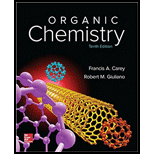
ORGANIC CHEMISTRY-PACKAGE >CUSTOM<
10th Edition
ISBN: 9781260028355
Author: Carey
Publisher: MCG CUSTOM
expand_more
expand_more
format_list_bulleted
Concept explainers
Question
Chapter 17.11, Problem 14P
Interpretation Introduction
Interpretation:
A sawhorse or Newman projection formula for the product of the given reaction and the description of chiral centers of both reactants and products according to Cahn-Ingold-Prelog rules are to be determined.
Concept Introduction:
The
The numbering that is assigned to the groups that are bonded to the chiral carbon is done on the basis on the molecular weight and electronegativity of the respective groups.
>If the sequence of the numbering follows clockwise direction, the chiral atom is assigned with
Expert Solution & Answer
Want to see the full answer?
Check out a sample textbook solution
Students have asked these similar questions
Draw the Fischer projection from the skeletal
structure shown below.
HO
OH
OH
OH
OH H
Q
Drawing
Atoms, Bonds
and Rings
Charges
I
☐
T
HO
H
H
OH
HO
I
CH2OH
H
OH
Drag
H
OH
-CH2OH
CHO
-COOH
Undo
Reset
Remove
Done
please provide the structure for this problem, thank you
presented by Morallen Lig
Intermine the hand product for the given mution by adding atoms, bonds, nonhonding diarion panda
скуль
Step 3: Comp the draw the product
Step 2: Agama workup Compithe
429
ملولة
Chapter 17 Solutions
ORGANIC CHEMISTRY-PACKAGE >CUSTOM<
Ch. 17.1 - Prob. 1PCh. 17.2 - The heats of combustion of 1, 2-epoxybutane...Ch. 17.3 - Prob. 3PCh. 17.4 - Prob. 4PCh. 17.5 - Prob. 5PCh. 17.6 - Problem 17.6 (a) Write equations describing two...Ch. 17.6 - Problem 17.7 Only one combination of alkyl halide...Ch. 17.6 - Prob. 8PCh. 17.8 - Prob. 9PCh. 17.8 - Prob. 10P
Ch. 17.9 - Prob. 11PCh. 17.10 - Problem 17.12 Classify the bromohydrins formed...Ch. 17.11 - Prob. 13PCh. 17.11 - Prob. 14PCh. 17.12 - Prob. 15PCh. 17.12 - Prob. 16PCh. 17.14 - Prob. 17PCh. 17.15 - Prob. 18PCh. 17.16 - Prob. 19PCh. 17.17 - Problem 17.20 There is another oxygen-stabilized...Ch. 17 - Prob. 21PCh. 17 - Many ethers, including diethyl ether, are...Ch. 17 - Although epoxides are always considered to have...Ch. 17 - The name of the parent six-membered...Ch. 17 - Prob. 25PCh. 17 - Prob. 26PCh. 17 - Prob. 27PCh. 17 - Prob. 28PCh. 17 - Prob. 29PCh. 17 - Given that: does the product of the analogous...Ch. 17 - Prob. 31PCh. 17 - Prob. 32PCh. 17 - Prob. 33PCh. 17 - Prob. 34PCh. 17 - Prob. 35PCh. 17 - Prob. 36PCh. 17 - When (R)-(+)-2-phenyl-2-butanol is allowed to...Ch. 17 - Prob. 38PCh. 17 - Prob. 39PCh. 17 - Write a mechanism for the following reaction.Ch. 17 - Prob. 41PCh. 17 - Prob. 42PCh. 17 - Prob. 43PCh. 17 - Prob. 44PCh. 17 - Prob. 45PCh. 17 - Prob. 46DSPCh. 17 - Prob. 47DSPCh. 17 - Prob. 48DSPCh. 17 - Prob. 49DSPCh. 17 - Epoxide Rearrangements and the NIH Shift This...Ch. 17 - Epoxide Rearrangements and the NIH Shift This...
Knowledge Booster
Learn more about
Need a deep-dive on the concept behind this application? Look no further. Learn more about this topic, chemistry and related others by exploring similar questions and additional content below.Similar questions
- Reaction A 0,0arrow_forwardpresented by Morillon Leaning Predict the organic product for the min кусур HSC Adithane carved arnown to come than that to the condon slchroruis in acid in in aquishri with ноюarrow_forward6.15PM Sun Mar 30 K Draw the major product of this reaction. Include any relevant stereochemistry. Ignore inorganic byproducts. Problem 1 of O H [PhзPCH2CH3]*C|¯ NaH Drawing > Q Atoms, Bonds and Draw or tap a nearrow_forward
- 8:17 PM Sun Mar 30 Draw the major product of this reaction. Ignore inorganic byproducts. HSCH2CH2CH2SH, BF3 Probler Drawing Ato Bonds Clarrow_forwardpresented by Mr L How the coprion. (Il Done in no wraction, dew the starting redential) доarrow_forward8:16 PM Sun Mar 30 K Draw the major product of this reaction. Ignore inorganic byproducts. Proble 1. CH3MgBr 2. H3O+ F Drawingarrow_forward
- о но оarrow_forwardName the major organic product of the following action of 4-chloro-4-methyl-1-pentanol in neutral pollution 10+ Now the product. The product has a molecular formula f b. In a singly hain, the starting, material again converts into a secule with the molecular kormula CIO. but with comply Draw the major organic structure inhalationarrow_forwardMacmillan Learning Alcohols can be oxidized by chromic acid derivatives. One such reagent is pyridinium chlorochromate, (C,H,NH*)(CICTO3), commonly known as PCC. Draw the proposed (neutral) intermediate and the organic product in the oxidation of 1-butanol by PCC when carried out in an anhydrous solvent such as CH₂C₁₂. PCC Intermediate OH CH2Cl2 Draw the intermediate. Select Draw Templates More с H Cr о Product Draw the product. Erase Select Draw Templates More H о Erasearrow_forward
- If I have 1-bromopropene, to obtain compound A, I have to add NaOH and another compound. Indicate which compound that would be. A C6H5 CH3arrow_forwardProvide the reagents for the following reactions.arrow_forwardIf I have 1-bromopropene, to obtain compound Z, I have to add two compounds A1 and A2. Indicate which compounds are needed. P(C6H5)3arrow_forward
arrow_back_ios
SEE MORE QUESTIONS
arrow_forward_ios
Recommended textbooks for you
